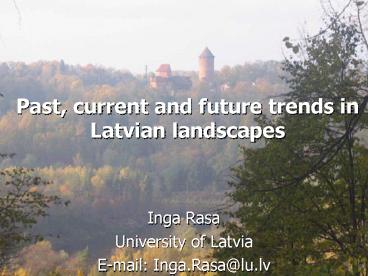Past, current and future trends in Latvian landscapes PowerPoint PPT Presentation
1 / 21
Title: Past, current and future trends in Latvian landscapes
1
Past, current and future trends in Latvian
landscapes
- Inga Rasa
- University of Latvia
- E-mail Inga.Rasa_at_lu.lv
2
- Rural landscape in Latvia is the result of
interaction between nature and human and has a
particular structure of land-use and settlement
dynamics
3
- The image of traditional Latvian landscape
often is associated with the rural landscape of
the 1st Latvias independence (1918 1940)
4
- Basic structure of rural landscape in Latvia
formed at the end of 19th century and at the
beginning of 20th century - large forest massives on less fertile soils,
- agricultural lands (arable lands, pastures,
meadows) with single farmsteads, - wetlands,
- unique cultural landscapes (river valleys, lake
surroundings)
5
- Since 1920ties the main tendencies are growth
of woodlands and decrease of agricultural lands
6
Research questions
- Changes of rural landscapes in Latvia during the
20th century - Factors influencing these changes
- Current and future trends in rural landscapes
7
- Materials and Methods
- Analysis of topographic maps, ortophotos and
other cartographic materials by using ArcGIS
software - Field work to analyse present tendencies of
land-use - Analysis of farmers applications for the EU
direct payments (single area payment), to
estimate possible changes of rural landscape in
future
8
Study areas
9
Types of land-use changes
- 1. Increase and homogenisation of large forest
massives
Barta parish at the beginning of the 20th century
Barta parish at the end of 20th century
10
Types of land-use changes
- 2. Formation of the mosaic-type landscape instead
of agricultural landscape (in morain uplands)
Nautreni parish at the beginning of the 20th
century
Nautreni parish at the end of 20th century
11
Types of land-use changes
- 3. Formation of woodland patches and large forest
massives (at the margins of rural muncipalities)
Vecsaule parish at the beginning of the 20th
century
Vecsaule parish at the end of 20th century
12
Types of land-use changes
- 4. Changes of unique cultural landscapes (e.g.
change of land-use in valley of Gauja river)
View from Gleznotaju kalns to the valley of
Gauja river in 1959
View from Gleznotaju kalns to the valley of
Gauja river in 2005
13
Valley of Gauja river at the end of the 20th
century
Valley of Gauja river at the beginning of the
20th century
14
Politics - the crucial factor causing changes in
rural landscapes during the 20th century
- Agricultural reforms
- Afforestation of agricultural lands
- Deportation of the inhabitants to Russia
- Elimination of single farmsteads and formation of
villages - Amelioration of agricultural lands
- Other factors
15
Current and future trends in rural landscapes in
Latvia
- Single area payment a payment for agricultural
land, which has mantained in good agricultural
and environmental conditions - Agricultural land is cultivated
- At least yearly pastures, meadows and perennial
graslands are cut or pastured - There are no shrubs or weeds in agricultural
land - Agricultural land is not bogged up or afforested.
- Single area payment can get for all agricultural
land, which corresponds to the receipt
conditions.
16
Farmers application for the EU Single area
payment in 2005 (Barta parish)
17
Farmers application for the EU Single area
payment in 2005 (Nautreni parish)
18
Farmers application for the EU Single area
payment in 2005 (Vecsaule parish)
19
Farmers application for the EU Single area
payment in 2005 (Gauja national park)
20
Conclusions
- In the 20th century the rural landscape in Latvia
has become, on the one hand, more homogeneous, on
the other more heterogeneous - With the present land-use tendencies in Latvia,
woodlands will increase and the agricultural
lands will decrease - The main factors influencing these changes are
economic, social factors and land owners
decisions to use or not to use the agricultural
land
21
Thank you for your attention!

